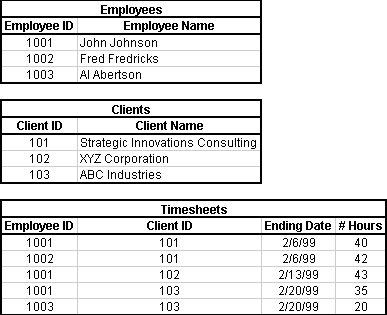Data Normalization - Exercise Result
You entered 1:You entered 2:
for response 1:
The figure below illustrates one way in which the data in the sample table might be normalized into three new tables.

- Question: How many tables are required to normalize the data effectively, and what will they be titled?
Response: To normalize the data in the original table, you must create three tables titled "Employees," "Clients," and "Timesheets." To arrive at this answer, you must first consider which columns in the original table contain repeating data. The Employee and Client columns each repeat data. Because each of these columns describes an entity by itself, each needs to be broken into its own table.
That leaves the Week Ending Date and Hours Worked columns. These each describe timesheet data, so they are placed into a table called "Timesheets."
- Question: How many columns will be included in each of the new tables, and what will their headings be?
Response: The new Employees table will contain two columns labeled "Employee ID" and "Employee Name." The Clients table will likewise contain two columns labeled "Client ID" and "Client Name." The Timesheets table will contain the same number of columns as the original table, labeled "Employee ID," "Client ID," "Ending Data," and "#Hours." Because there is a relationship between the tables, each is linked by an ID column located in the Timesheets table and each of the other two tables.